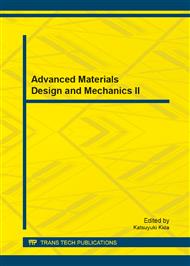[1]
R. A. Grange and E. R. Shackelford, U.S. Patent 3, 178, 324. (1965).
Google Scholar
[2]
S. W. Mahajan: Metallograohy, Vol. 6 (1973), pp.337-345.
Google Scholar
[3]
R. A. Grange: Metallurgical and Materials Trans. A, Vol. 2 (1971), pp.65-78.
Google Scholar
[4]
T. Hijikata, T. Yamazaki and K. Fujita, U.S. Patent 4, 222, 799. (1980).
Google Scholar
[5]
M. Tokizane, N. Matsumura, K. Tsuzaki, T. Maki and I. Tamura: Metallurgical and Materials Trans. A, Vol. 13, No. 8 (1982), pp.1379-1388.
DOI: 10.1007/bf02642875
Google Scholar
[6]
S. Bozo: Journal of Materials Processing Technology, Vol. 155, No. 156 (2004), pp.1704-1707.
Google Scholar
[7]
T. Fujimatsu, M. Nishikawa, K. Hashimoto and A. Yamamoto: Materials Science Forum, Vols. 561-565 (2007), pp.2345-2348.
DOI: 10.4028/www.scientific.net/msf.561-565.2345
Google Scholar
[8]
C. Ooki, K. Maeda and H. Nakashima: NTN Technical review, No. 71 (2004), pp.2-7.
Google Scholar
[9]
H. Koike, E. C. Santos, K. Kida, T. Honda and J. Rozwadowska: Advanced Material Research, Vols. 217-218 (2011), pp.1266-1271, DOI: 10. 4028/www. scientific. net/AMR. 217-218. 1266.
DOI: 10.4028/www.scientific.net/amr.217-218.1266
Google Scholar
[10]
E. C. Santos, K. Kida, T. Honda, J. Rozwadowska, K. Houri and K. Hashimoto: Advanced Material Research, Vols. 217-218 (2011), pp.982-987, DOI: 10. 4028/www. scientific. net/AMR. 217-218. 982.
DOI: 10.4028/www.scientific.net/amr.217-218.982
Google Scholar
[11]
K. Mizobe, E. C. Santos, T. Honda, H. Koike, K. Kida and T. Shibukawa: Advanced Material Research, Vols. 457-458 (2012), pp.1025-1031, DOI: 10. 4028/www. scientific. net/ AMR. 457-458. 1025.
DOI: 10.4028/www.scientific.net/amr.457-458.1025
Google Scholar
[12]
ARKOWIZ, M., Introduction to Homotopy Theory (Universitext),. Springer Press (2011).
Google Scholar
[13]
NAKANE, K., TSUCHIHASHI, Y. and MATSUURA, N., A Simple Mathematical Model Utilizing a Topological Invariant for Automatic Detection of Tumor Areas in Digital Tissue Images, to appear Diagnostic Pathology.
DOI: 10.1186/1746-1596-8-s1-s27
Google Scholar
[14]
CHomP (Computational Homology Project), http: /chomp. rutgers. edu.
Google Scholar
[15]
Koshiro Mizobe, Takashi Honda, Hitonobu Koike, Edson Costa Santos, Katsuyuki Kida and Takuya Shibukawa, Observation of fisheye cracks around TiN and Al2O3 inclusions in repeatedly quenched high carbon bearing steel, Advanced Materials Research (Trance Tech Publications, ISSN: 1022-6680), Vol. Vol. 566, pp. pp.150-156.
DOI: 10.4028/www.scientific.net/amr.566.150
Google Scholar


